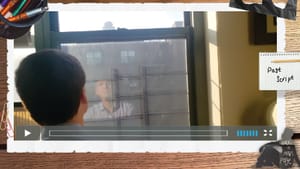Stay in the Loop
BSR publishes on a weekly schedule, with an email newsletter every Wednesday and Thursday morning. There’s no paywall, and subscribing is always free.
No longer alone
McCarter Theatre Center presents ‘The Manic Monologues’

Unfortunately, the title of the piece completely misrepresents the event. The Manic Monologues, currently streaming on the McCarter Theatre Center website, is utterly lacking in euphoria. Rather, it is, by turns, agonizing, harrowing, hopeful, and ultimately edifying. Promising to start a conversation about mental health is the hoariest of psychiatric clichés, but this work manages to do it, even if that conversation is entirely self-contained.
Familiar form, tough content
Entering the experience, viewers are greeted by a splash page featuring 21 figures in silhouette, black on a white background. Each figure has its own unique physical presentation, often augmented by a relevant accessory such as a barbell or umbrella. Most of these figures are in midair, each clutching their own individual rope. While the visual metaphor is a bit on the nose, it is an appropriate representation of the texts to come. Click on a figure, and you go to a corresponding monologue, which lasts anywhere from a minute to just over six.
The visual presentation of the monologues is styled after the experience of watching a YouTube video, and the comfort of that familiar form helped me navigate the emotionally treacherous terrain of the presentations. The show affords no easy entrance and very little respite. Each monologue is presented as an interview with an individual, and each individual is negotiating a different aspect of mental illness. Topics covered include OCD, PTSD, major depressive disorder, suicidal ideation, and tardive dyskinesia. Trigger warnings appear before viewing some monologues, and these warnings are clear and appropriate. In addition, there are resource guides should you wish to learn more.
Opportunities of form and function
The vast majority of monologues have a virtual slip of paper which appears to the right of the video after its conclusion. The paper is marked Post Script, and upon clicking it, you learn the first initial of the person whose story is being told, as well as what they are doing now. The texts themselves are stories of real people, performed by actors. Although this approach both raises the production value and avoids retraumatizing individuals, it misses an opportunity to take the work to a level of profundity that could be achieved were the function of the piece—letting the voices of those struggling with mental illness be heard—replicated in its form.
The work is so focused on its message that it seems a disservice to mention the messengers, but the two performers who had the greatest effect on me were Mateo Ferro and Heather Alicia Simms. Overall, the naturalistic nature of the piece combined with the subject matter compels the viewer, and its emotional punch is owed to Elena Araoz’s fearless yet sensitive direction.
Heartbeats and doodling
One outstanding feature of the work is the care the piece takes with its virtual audience. Before we enter, we learn that we can travel through the piece at our own pace. Upon entering, we discover a heart button that we can press in time with our own heartbeat, as well as virtual colored pencils for doodling. I believe this thoughtfulness is a result of the unique collaboration between the Innovations in Socially Distanced Performance program and Princeton University Health Services, who make up half of the producing team.
A worthy visit
The Manic Monologues were born out of cocreator Zack Burton’s psychotic break while a PhD candidate in geology at Stanford University. The break brought about worrisome changes in Burton’s personality that he and his then-partner Elisa Hofmeister worried were permanent. When it became clear that they were on their own, and there was no collection of others’ lived experiences to draw on, they decided to create what became The Manic Monologues.
The past 12 months have been incredibly difficult in multiple ways. So it is understandable if this performance’s starkly honest, no-punches-pulled exploration of mental illness makes you want to give it a miss. However, if you decide to engage with the work, and try the suggested guidelines (which I ignored completely), I guarantee it will be a worthy expenditure of your emotional energy.
Image description: A still from The Manic Monologues. Central in the image is a photo of someone looking out of a window on a dull city view. The person’s back is to the viewer and their face is faintly visible as a window reflection.
What, When, Where
The Manic Monologues. Originally created by Zachary Burton and Elisa Hofmeister. Virtual experience conceived by director Elena Araoz. An ongoing presentation of McCarter Theatre Center, Princeton University Health Services, 24 Hour Plays, and Innovations in Socially Distanced Performance. Explore it for free at mccarter.org.
Sign up for our newsletter
All of the week's new articles, all in one place. Sign up for the free weekly BSR newsletters, and don't miss a conversation.

 Brad Rothbart
Brad Rothbart